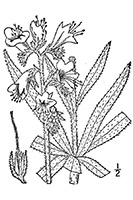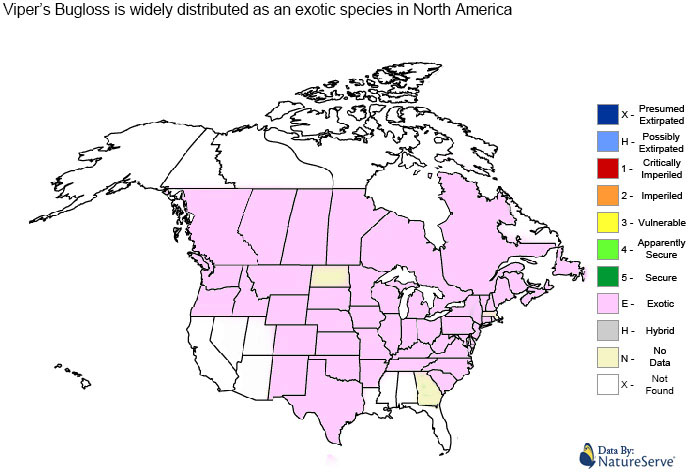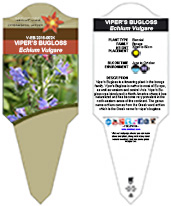

| Plant Name | Viper's Bugloss | |
| Scientific Name | Echium Vulgare | |
| Family | Borage | |
| Plant Type | Biennial | |
| Start of Blooming Season | June | |
| End of Blooming Season | October |

| Soil Conditions | |
| Soil Moisture | |
| Sunlight | |
| Notes: |

Viper's Bugloss is a biennial, or monocarpic perennial, plant growing to 30cm to 80cm tall, with rough, hairy, lanceolate leaves growing 1cm to 15cm long. Flowers form in a cyme scorpiod, one sided, cluster. Each flower starts as a pink bloom and matures into a blue, funnel shaped, 15mm to 20mm long bloom with five petals, five sepals, 5 stamens, and one long stalked pistil. The flowers of viper's bugloss are pollinated by Bees, flies, lepidoptera The plant produces four angular nutlet seeds in each flower.

| Plant Height | 30cm to 80cm |
| Habitat | Fields, Roadsides, Waste places |
| Leaves | Lanceolate |
| Leaf Margin | Ciliate |
| Leaf Venation | Cross-venulate |
| Stems | Hairy Stems |
| Flowering Season | June to October |
| Flower Type | Elongated clusters of funnel shaped florets |
| Flower Colour | Blue |
| Pollination | Bees, Insects |
| Flower Gender | Flowers are hermaphrodite and the plants are self-fertile |
| Fruit | Small Nutlets |
| USDA Zone | 3A (-37.3°C to -39.9°C) cold weather limit |

The following health hazards should be noted when handling or choosing a location to viper's bugloss:
 |
TOXICITY Viper's Bugloss contains a number of pyrrolizidine alkaloids. As a member of the genus Borage, it is considered to be potentially toxic. |
 |
SKIN IRRITANT |

 |
-Click here- or on the thumbnail image to see an artist rendering, from The United States Department of Agriculture, of viper's bugloss. (This image will open in a new browser tab) |

 |
-Click here- or on the thumbnail image to see a magnified view, from The United States Department of Agriculture, of the seeds created by viper's bugloss for propagation. (This image will open in a new browser tab) |

Viper's Bugloss can be referenced in certain current and historical texts under one other name:
Viper's Bugloss can be translated into the following select languages:
| Arabic | فيبرز بوغلوس | Bulgarian | Вибратори | Chinese (Sim) | |
| Croatian | Czech | Danish | |||
| Dutch | Esperanto | Estonian | |||
| Finnish | French | German | |||
| Greek | Hebrew | Hungarian | |||
| Italian | Japanese | バイパーズバグロス | Korean | ||
| Punjabi | ਵੀਪਰਾਂ ਬੁਗਲਾਸ | Lithuanian | Norwegian | ||
| Persian | Polish | Portuguese | |||
| Romanian | Russian | Slovak | |||
| Spanish | Swedish | Tagalog | |||
| Turkish | Ukrainian | Віперс Буглосс | Vietnamese |

| The information provided in this conservation assessment has been provided by the Natureserve Database in conjunction with various federal, provincial, state, county, district, regional, and municipal governments as well as public and private conservation authorities. Information in this section is accurate from the last time this article was updated. | |
 |
Viper's Bugloss has no conservation status as it is considered to be an invasive species in North America. |

 |

 |
The MIROFOSS database offers free printable garden tags for personal and non-profit use. These tags can be used to properly identify plant samples in a garden. Click on the tags shown on the the screen or -click here- to download a full size jpeg image for a viper's bugloss identification tag; which can be printed on paper or used with a plastic laser printer. |
 |
What's this? What can I do with it? |

| Description | Dickinson, T.; Metsger, D.; Bull, J.; & Dickinson, R. (2004) ROM Field Guide to Wildflowers of Ontario, Royal Ontario Museum, Toronto:McClelland and Stewart Ltd. |
| Description | Fitter, R. & A. (1974). The Wild Flowers of Britain and Northern Europe. Collins. |
| Description | Kartesz, J.T. 1994. A synonymized checklist of the vascular flora of the United States, Canada, and Greenland. 2nd edition. 2 vols. Timber Press, Portland, OR. |
| Biology | Kartesz, J.T. 1996. Species distribution data at state and province level for vascular plant taxa of the United States, Canada, and Greenland (accepted records), from unpublished data files at the North Carolina Botanical Garden, December, 1996. |
| Folklore | MacKinnon, Kershaw, Arnason, Owen, Karst, Hamersley, Chambers. 2009. Edible & Medicinal Plants Of Canada ISBN 978-1-55105-572-5 |
| Image Rendering | USDA-NRCS PLANTS Database / USDA NRCS. Wetland flora: Field office illustrated guide to plant species. USDA Natural Resources Conservation Service. |
| Environment | National Audubon Society. Field Guide To Wildflowers (Eastern Region): Alfred A. Knopf. ISBN 0-375-40232-2 |
| Physical Identification | National Audubon Society. Field Guide To Wildflowers (Eastern Region): Alfred A. Knopf. ISBN 0-375-40232-2 |
| February 01, 2018 | The last time this page was updated |
| ©2021 MIROFOSS™ Foundation | |
 |